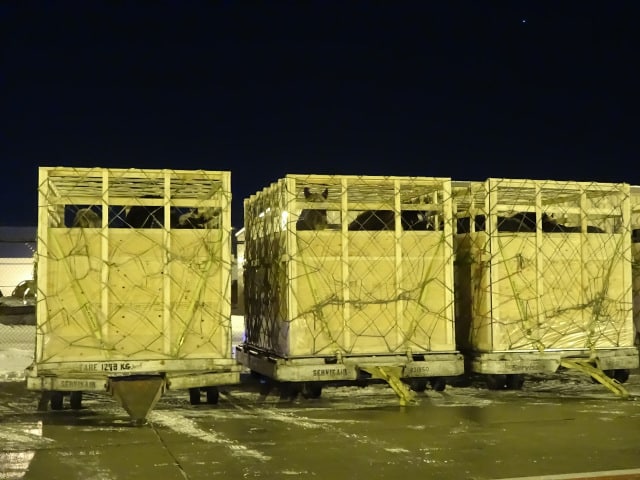
16 Animal Welfare Risks Associated with Horse Exportation

- Horses purposely bred for slaughter are raised in barren, open feedlots. Draft horses raised for slaughter have been documented as raised in feedlots without shelter or protection from the elements. The province of Manitoba is home to two producers of draft horses for exportation, yet the province sees some of the harshest and coldest weather conditions in the country. Like companion horses, draft horses must be provided with appropriate shelter in extreme weather conditions.
- Horses raised for slaughter are at risk of having pain control withheld. Phenylbutazone, a non-steroidal anti-inflammatory drug, is the most effective and most commonly used drug to treat chronic and acute pain in horses. Phenylbutazone is also banned for use on horses raised for human consumption. This leaves horses raised for slaughter at risk of not having acute or chronic pain appropriately addressed and treated.
- There is no way to desensitize horses ahead of the exportation process. Horses raised for exportation do not have an opportunity to leave the feedlot until they are transported for slaughter. They are prey animals with strong fight-or-flight instincts who, for the first time in their lives, are exposed to a variety of unfamiliar, stressful and frightening stimuli during the exportation process.
- Horses are prone to auditory distress. Horses can hear a greater range of sound than the average human ear and have been documented to show visible signs of distress at sounds louder than 100 decibels. The average volume of a cargo jet landing on a runway can exceed 140 decibels, a volume so loud that humans risk permanent hearing damage if exposed for long durations of time. Despite this, shipments continue to be documented with crated horses sitting on the tarmac at Winnipeg’s James Armstrong Richardson International airport while cargo jets land on runways directly beside the animals. The volume level of the cargo jet’s landing is not only deafening, but it is also terrifying for these easily panicked animals.
- Inertia. Horses have a high center of gravity, with 60% of their weight placed on the front end of their bodies. When planes are ascending and descending, their center of gravity becomes displaced, and horses are at extreme risk of injury and distress as a direct result of their loss of balance.
- Harsh handling techniques have been documented. Watchdog groups have documented horses being jabbed with metal rods during the unloading process at the Winnipeg James Armstrong Richardson International airport. This type of physical abuse is unacceptable and inhumane.
- Horses cannot handle long durations of time without food, water or rest. The process of withholding food and water from horses for durations longer than 24 hours has been scientifically proven to cause severe dehydration and increased risk of injury from fatigue for the animals. Currently, horses are permitted to travel up to 28 hours without food, water or rest as outlined in the federal Health of Animals Regulations, however, studies show that any transportation time frame nearing 24 hours is enough to make horses physically compromised.
- Horses are prone to colic when water consumption is reduced. Insufficient water intake has been proven to be a direct cause of intestinal irritation and blockages in horses, resulting in colic. When horses are transported for 24+ hours without access to water, they are at significant risk of dehydration and succumbing to painful intestinal colic. Additionally, section 4.2.1 of the National Farm Animal Care Council’s Code of Practice for the Care and Handling of Equines states that horses should be provided with ‘safe, palatable and clean water at all times to reduce the risk of colic.
- Shipments do violate the permitted 28-hour transportation time. A recent shipment out of Winnipeg’s James Armstrong Richardson International airport on Monday, December 12th, 2022 saw significant delays while at the airport, resulting in a transportation time of roughly 32 hours total as recorded by watchdog groups. Previous shipments out of Winnipeg have also been documented as having transportation times of 31 and 36 hours, respectively. Any minor delay in transportation makes it very easy to violate the currently permitted time allowance of 28 hours, forcing the animals to endure even longer stretches of time without food, water or rest and jeopardizing their physical well-being.
- There is no way to successfully assess the temperament of horses during the crate loading process. During the loading process, horses are randomly paired in crates without attention to their compatibility. Horses have been documented as receiving severe injuries from being kicked by other horses while in the crates.
- Horses cannot turn around or rest during transportation. Crates used for air transportation provide no opportunity for horses to turn around or move during transportation. As outlined above, horses are at increased risk of injury from fatigue when in transportation for periods longer than 24 hours without appropriate space or rest.
- There is no way to intervene if something does go wrong. If a horse is in psychological or physical distress, there is no way to intervene once the plane has left Canada. No one monitors the horses during the flight process, and if something goes wrong, there is no way to alleviate the suffering of the animal onboard. As such, access to information requests has shown instances of horses succumbing to fatal injuries during exportation overseas.
- The lack of transparency and accountability once horses arrive in Japan. Once horses arrive in their destination country, it is incredibly difficult to obtain records on their care and slaughter. There are multiple ways in which horses can continue to experience pain, fear and distress once in their destination country, however access to such information is not readily available. There are also no records available to know when horses are once again provided with water and food once they arrive in their destination country, thus risking the permitted 28-hour period without food or water to be much, much longer.
- Many countries are now moving to ban live exports of livestock overseas. Countries such as New Zealand and Germany are moving to pass legislation to end the exportation of livestock overseas because of ongoing animal welfare concerns associated with overseas transportation. Despite this, Canada continues to export horses overseas for a niche, luxury product that provides no economical contribution to Canada’s economy. Canada has an opportunity to be a leader in animal welfare by stopping the exportation of live horses for slaughter.
- Violations continue to be documented by watchdog groups. On addressing space requirements for horses during transportation, section 14.1 of Canada’s Health of Animals Regulations states that a horse must be ‘able to maintain its preferred position with sufficient space to permit a full range of head movement.’ Despite this, horses continue to be documented by watchdog groups as not having sufficient head clearance from the top of the crates to allow for the horses to maintain a preferred, natural head position during transportation by air.
- There is a blatant difference in how horses raised for show and horses raised for slaughter are treated during transportation. Horses raised for exportation are not given the same care and consideration as horses being imported or exported for pleasure and show, who have accompanying attendants during flights, and access to food, water and rest throughout their journey. This drastic difference in treatment is inexcusable and is a red flag for animal welfare groups. Canadians do not support Canada’s horse exportation industry and continue to speak out against the blatant mistreatment of draft horses raised for slaughter.
Take Action: Canadians have until February 7th,2023 to sign and share the following House of Commons petition e-4190, which was created by Canadian icon Jann Arden and demands an end to horse exportation for slaughter.
Sign here: https://petitions.ourcommons.ca/en/Petition/Details?Petition=e-4190

